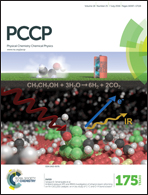Catalytic conversion of CHx and CO2 on non-noble metallic impurities in graphene†
Abstract
Density functional theory (DFT) was applied to investigate the geometric, electronic, and magnetic properties of CHx (x = 0, 1, 2, 3, 4) species on non-noble metal embedded graphene (NNM-graphene). It was found that the different stabilities of CHx species can modify the electronic structures and magnetic properties of NNM-graphene systems. The carbonaceous reforming reactions include conversion of CHx (x = 0, 1, 2 and 3) species by hydrogen molecules (H2) to form CHx+2 species or oxidation of C atoms by oxygen molecules to form CO2. In the hydrogenation reactions, deposited C atoms can be converted easily into CHx species overcoming small energy barriers. In comparison, coadsorption of C and O2 to generate CO2 encounters relatively larger energy barriers on the NNM-graphene. Hence, the coadsorption of CHx and H2 as the starting state is energetically more favorable and formation of CHx species can reduce amounts of carbon deposition. Among the NNM-graphene substrates studied, moderate adsorption energies and low reaction barriers of CHx species are more likely to occur on the Co-graphene surface, thus the hydrogenation reaction is able to inhibit carbon deposition on the NNM-graphene surface while maintaining high activity.


 Please wait while we load your content...
Please wait while we load your content...